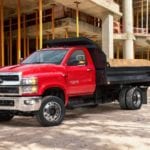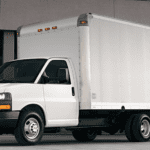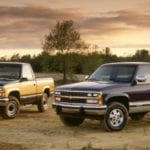Shopping for a used truck is not always easy, no matter how much you might want it to be. Sure, you can pull up a search engine, type in “used trucks for sale,” and hope for the best, but even if that’s your approach (which isn’t the worst way to start), what do you do then? You’re going to get millions of results, and even if you just stick with the first page, you’ll have more options than you know what to do with.
To me, one of the best ways to cut through all that clutter and get a real sense of what’s out there is to take emotional and qualitative aspects out of the picture. Stick to the numbers and the quantitative measurements that are listed for different used trucks for sale. To be fair, this might not work for everyone, and it’s probably only one part of the overall process. But it’s a great way to compare different models in a way that is more data-driven — a scientific approach to used truck shopping: easy enough.
Qualitative vs. Quantitative Specs
First off, let’s look at what “qualitative” and “quantitative” mean, specifically concerning used trucks for sale. In general, the word “qualitative” deals with the quality of something and non-numerical information. On the other hand, “quantitative” means something numerical in nature, dealing with the quantity of something.
So, in other words, if you look at whether a truck has basic air conditioning or dual-zone climate control, then that is a qualitative factor. While considering the horsepower available from two different engines is a quantitative approach. This way to shop for trucks is all about the quantitative information: numbers that we can easily see and compare. The qualitative stuff is essential, but we’re going to ignore it for now.
Model Year and Generation
One of the first numbers you’ll see when looking at any used truck is the model year. Don’t get too hung up on whether it was built or sold in any particular year; look at the year indicated and use that for your research. When you’re interested in something like a 2018 Chevy Silverado 1500, for example, take a moment and do some research on that particular year.
Look at reviews from owners of that truck from that year and see what they have to say. You can learn a lot about a truck you’re interested in by looking at what people say about it specifically. It’s also worth noting that you can use the model year to see what generation a used truck belongs to within its manufacturing run. In general, it’s usually best to avoid used trucks from the first year of a generation whenever you can. The first year in a remodel traditionally tends to have the most issues while later years improve upon or fix flaws that were originally there.
Engines – Horsepower and Torque
Overall power and performance of a truck can depend on many factors, including how it’s constructed, and what materials they used to build the frame. That stuff can be hard to quantify, however, whereas the power of the truck’s engine is much easier to look at and gauge. When you compare engines, you’re going to look at two main numbers: horsepower and torque.
Without going into too much detail, torque refers to the rotational force that’s being generated by the engine of a vehicle. While horsepower is an expression of how that torque ultimately performs work by moving the vehicle forward, this can become complicated. There’s a good amount of math and physics involved – but the takeaway is that both of these numbers are important when it comes to the performance of a truck.
The simple way to view horsepower and torque when looking at used trucks for sale is this: more is better. You want high horsepower and high torque whenever possible. If you’re looking for a heavy-duty pickup to get a lot of work done with a high towing capacity, then these numbers are even more critical, especially torque.
Transmission and “Speed”
While you’re looking at the engines of any used trucks for sale, you should also look at the transmission. Newer used models will almost always have automatic transmissions, as manual transmissions in pickups have become relatively rare. You’ll see the transmission labeled as a “6-speed” or “8-speed,” which indicates how many gears the transmission has. While there is a point of diminishing returns here, in general, more gears make for a smoother ride and can improve fuel economy and overall performance.
Capability – Towing and Payload
Here you will find two of the most important numbers listed for used trucks for sale: the towing capacity and payload. Towing capacity refers to how much weight you can pull behind the vehicle with a hitch connecting it to your truck. It does not include the weight of the truck at all – just the weight behind you. This can be a trailer or camper or anything else really, but it does include the weight of the trailer itself.
Payload, on the other hand, refers to how much weight the truck itself can bear. This includes the driver, any passengers, cargo in the cab, and everything piled in the bed of the truck. If you tend to load up your truck with lumber or sheets of drywall directly in the bed, then the payload is a significant number. Be sure to look for these for a specific truck, not just general model numbers, as a lot of factors involving trim levels and options can affect them.
Sizes – Inside the Cab and Truck Bed
A few more important numbers to look at when considering different used trucks for sale are the sizes of them. You can look at overall length, width, and height of different trucks, as well as their various capacities. The size of the cab, for example, is usually indicated indirectly as a description – but you can also find specific numbers related to legroom and overhead height. When looking at cabs: regular cabs are the smallest, then extended or double cabs, and finally, crew cabs are the largest.
Similarly, you should look at the size of the truck bed to make sure it can fit anything you need to load into it. The names here are pretty straightforward: short beds are usually a little under 6-feet long, standard beds are about 6-and-a-half-feet long, and long beds are about 8-feet long. You can easily find specific numbers for any truck you’re interested in by looking up the year, and the type of bed indicated.
Final Tally
At the end of the day, this approach to looking at used trucks for sale can help you with shopping by taking a lot of difficult decisions out of the equation. Rather than getting bogged down with details like the brands of speakers different trucks have, or whether they have leather seating, focus on numbers that directly impact how the truck performs. Know what you want out of a truck. That makes it a lot easier to narrow down your options and find what you truly need.
Then, of course, you’ll want to look at the qualitative features of different trucks. But by looking at the numbers first, you can more easily cut through all the clutter and find something that works for you.






